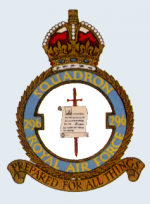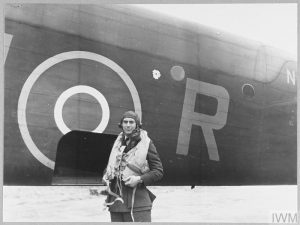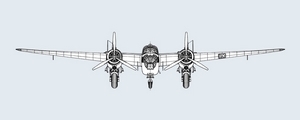
Badge: In Front of a Sword in pale, the point downwards a scroll
Motto: ‘Prepared for all things’
HISTORY
Squadron Code Letters ‘7C’ & ‘9W’.
No.296 Squadron was formed, on 25 January 1942, at Ringway from the ‘Glider Exercise Unit’ and a few days later went to Netheravon to tow Hotspur Gliders on training flights.
In May 1942, it began to receive Armstrong Whitworth Whitleys and, in July 1942, divided into 296A and 296B Squadrons.
On 25 July 1942, 296A (Hawker Harts) moved to Hurn, becoming the entire Squadron and 296B (Hawker Hectors) was re-designated ‘The Glider Pilot Exercise Unit’ (GPEU), No.38 Group.
In October 1942, No.296 began nickelling (leaflet dropping) flights over France (until May 1943) and in January 1943 began converting to Armstrong Whitworth Albemarles.
But with the creation of No.295 Squadron on 03 August 1942, the third Squadron created in No.38 Group, No.296 and also No.297 Squadron had participated in exercises where the 3 Squadrons had to tow General Aircraft Hotspur gliders to Ireland to train Irishmen of Airborne Division.
32 Albemarles were flown out to Froha, Algeria, on 03 June 1943, to take part in the airborne landings in Sicily. No.296 flew in Operation ‘HUSKY’: Codename of the Allied invasion of Sicily which started on 9 July 1943 ; in Operation ‘CHESTNUT’: A British commando raid of 2 small teams in the night of 12 July 1943, and in Operation ‘FUSTIAN’: The Air lift of 1st Parachute Brigade, on early morning hours of 14 July 1943, to capture the Primrose Bridge, South of Catania, Sicily (It is of particular note that at the same place, and nearly at the same time, near the Primrose Bridge were also dropped German Parachute Regiments).
No.296 returned to the UK in October 1943.
06 June 1944: Operation ‘OVERLORD’, the Invasion of Europe.
On the eve of ‘D-Day’ (See also No.297 Squadron History) for No.296 Squadron was the beginning of Operation ‘TONGA’. No.296 Squadron began with 3 aircraft. The very first No.296 Squadron Albemarle (Flight Lieutenant Whitty) took off at 23:00 hrs from Brize Norton with 9 Pathfinders of 22nd Independent Parachute Company on board, who were to locate and mark the Dropping Zones (DZs) for the main force. Flight Lieutenant Whitty was followed by Wing Commander McMonnies and Squadron Leader Archer who had to drop troops of 5th Parachute Brigade of Brigadier J H N Poett (Brigadier Poett was in aircraft of Wing Commander McMonnies). The principal task of 5th Parachute Brigade was to support the Pathfinders and to reinforce Major Howard’s company (see also No.298 Squadron History). The 3 first aircraft completed their task but they had been followed since 23:43 hrs by 8 aircraft, always for Operation ‘TONGA’, (they were 10 but 2 went u/s and it was too late to replace them) with men of 5th Parachute Brigade (the main paratroop force). All aircraft dropped without mishap with the exception of Flight Lieutenant Scott who had to make 4 runs: In the stick he had to drop was a dog and the dog had taken refuge in the gunner’s turret!
8 more aircraft took off, in the night of 06 June 1944, for ‘TONGA’, from 01:43 hrs, to release Horsa gliders loaded with troops of 5th Parachute Brigade and heavy equipment like bulldozers of 6th Airborne Divisional Engineers. Sadly, Flight Sergeant Jones, the rear gunner of Flying Officer Bull’s aircraft was wounded by a bullet fired from the ground. The aircraft landed at Ford for medical aid but Flight Sergeant Jones died in hospital.
After ‘TONGA’ was Operation ‘MALLARD’, the delivery by glider of the remainder of the 6th Airborne Division just before dusk. The crews who had returned from ‘TONGA’ slept in the morning. Briefing at 14:30 hrs and aircraft marshalled by 17:00 hrs.
No.296 Squadron supplied 20 aircraft from Brize Norton for ‘MALLARD’. Aircraft of No.297 Squadron took off first from 18:48 hrs followed by aircraft of No.296 but the 25th glider, towed by Flying Officer G.S. Vaughan crashed on take-off causing delay. The remaining were all airborne at 19:47 hrs and flew at 500 feet ASL. On DZ, gliders were released at 1000 feet ASL. Concentration was excellent and 17 of the 19 gliders towed by No.296 released between 21:13 and 21:15 hrs but near the release point was one Anti Aircraft position which gave trouble to aircraft. Several were hit. Flying Officer Wilson’s aircraft was seen on fire but the crew returned safely with the exception of the rear gunner, Pilot Officer Smith, who was not seen leaving the aircraft. The aircraft of Flight Lieutenant Hilton was badly shot up and made a crash landing at Greenham Common. The rest of the aircraft landed safely at night.
Like other No.38 Group Squadrons, No.296 Squadron flew SOE and SAS missions during the war. By example, with other No.38 Group Squadrons, on 07 June 1944, 3 aircraft of No.296 flew an Operation known as ‘COONEY PARTY’ ; a ‘COONEY PARTY’ was the drop of SAS teams in occupied territories to commit acts of sabotage on Railways and telephone. This night from 07 to 08 June 1944, 16 SAS teams were dropped by No.38 Group in Brest Peninsular (Each aircraft of No.296 Squadron carried this night 6 SAS men of 4th French Para Battalion, SAS B).
On 15 September 1944, No.296 Squadron, and other Albemarle Squadrons, were relocated at Manston. Kenneth FRERE, Pilot of No.296 Squadron, writes in his article ‘Albemarles at Arnhem‘, published on this Site: ‘From 2 September onwards we spent our time moving Horsa gliders over to Manston, as near to Holland as it was possible to get. On 15 September the Albemarle Squadrons were all relocated at Manston in readiness for Operation ‘MARKET’, the airborne element of ‘MARKET GARDEN’.
25 Gliders were towed by No.296 Squadron on the opening day, 17 September 1944, followed by 21 more on the following day without loss (Read details in ‘Albemarles at Arnhem‘ by Kenneth FRERE, and also the DFC awarded to F/Lt. Boyer).
Conversion to Halifaxes (Merlin-powered A Vs) began at the end of September 1944 and supply drops to resistance forces resumed.
No.296 Squadron re-equipped in Halifaxes A IIIs in February 1945 and flew in Operation ‘VARSITY’, the Crossing of the Rhine (and the greatest airborne Operation of all time). 30 Halifaxes of No.296 Squadron took part in the Rhine crossing on 24 March 1945.
At the end of the war troops were flown to Denmark & Norway (Operations ‘SCHNAPPS’ and ‘DOOMSDAY’ respectively), followed by flights bringing released prisoners of war back to the UK.
In December 1945, mail flights to India began but the Squadron disbanded on 23 January 1946.

Commanding Officers
25 January 1942 Squadron Leader P.B.N. DAVIS DSO
(KiA as O.C. No.299 Squadron during Operation ‘MARKET III’ on 19 September 1944)
17 May 1942 Wing Commander P.C. PICKARD DSO & 2 Bars, DFC
July 1942 Squadron Leader ( ) FOREMAN (*)
August 1942 [Squadron Leader A.B. WILKINSON DFC(US) (*)
[Squadron Leader B.R. MACNAMARA OPW2(USSR) (*)
OPW2(USSR): Order of the Great Patriotic War (Second Class) – Union of Soviet Socialist Republics

October 1942 Squadron Leader P.M.V. LYSAGHT (*)
(*): All Flight Commanders and acting O’s.C.
26 October 1942 Wing Commander P.R. MAY AFC, DFC (US), Gold Medal (Chinese Air Force)
(KiA, 12 July 1943)
15 July 1943 Wing Commander L.C. BARTRAM
(Injured in road accident and taken to hospital on 25 August 1943)
26 August 1943 Wing Commander D.I. McMONNIES
12 September 1944 Wing Commander T.C. MUSGRAVE OBE, DFC
(Had lost one leg in glider accident in August 1943)
December 1945 Wing Commander H.E. ANGELL DFC

Date / Base / Aircraft
25 January 1942 Squadron formed at Ringway Manchester in No.38 Group (the Glider Exercise Unit redesignated)
January 1942 / Ringway Manchester / Hawker Hector, Hawker Hart
01 February 1942 / Netheravon Wiltshire / Hawker Hector, Hawker Hart
May 1942 / Netheravon Wiltshire / Whitley V, Hawker Hector, Hawker Hart
25 July 1942 / Hurn Dorset / Whitley V, Hawker Hector, Hawker Hart
August 1942 / Hurn Dorset / Whitley V
25 October 1942 / Andover Hampshire / Whitley V
19 December 1942 / Hurn Dorset / Whitley V
January 1943 / Hurn Dorset / Albemarle I, Whitley V
March 1943 / Hurn Dorset / Albemarle I
3 June 1943 / Air echelon to Froha Algeria / Albemarle I
03 June 1943 / Ground echelon to Stoney Cross
24 June 1943 / Air echelon to Goubrine II Tunisia and detachment at Cassibile Sicily / Albemarle I
15 October 1943 / Hurn Dorset / Albemarle I
November 1943 / Hurn Dorset / Albemarle I, Albemarle II
14 March 1944 / Brize Norton Oxfordshire / Albemarle I, Albemarle II
April 1944 / Brize Norton Oxfordshire / Albemarle I, Albemarle II, Albemarle V
August 1944 / Brize Norton Oxfordshire / Albemarle I, Albemarle II, Albemarle V, Albemarle VI
September 1944 / Brize Norton Oxfordshire / Albemarle I, Albemarle II, Albemarle V, Albemarle VI, Halifax V
29 September 1944 / Earls Colne Essex / Albemarle I, Albemarle II, Albemarle V, Albemarle VI, Halifax V
October 1944 / Earls Colne Essex / Halifax V
February 1945 / Earls Colne Essex / Halifax III
December 1945 / Earls Colne Essex / Halifax III, Halifax A.7
23 January 1946 Squadron Disbanded
Next page: 297 Squadron

